Car radiator
What does a car radiator do?
A car radiator removes heat from an engine. An internal combustion engine burns a gas or diesel fuel to generate heat energy and then transforms that heat energy into mechanical energy. The average engine is only about 25-30% efficient. In other words, approximately 70-75% of the heat generated during combustion isn’t used to make power. So some of the heat is used to produce mechanical energy, some is lost out the tailpipe as exhaust and the rest is absorbed by the antifreeze coolant. Car radiators are made from various materials like copper, brass, plastic and aluminum.
Copper brass radiator
Most older radiators were made with a copper core with 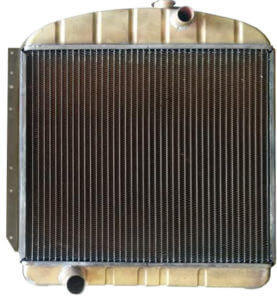 brass tanks. The copper tubes are soldered to a header and footer stamped piece and soldered together. Then the brass tanks are soldered onto the core. The weak link in a traditional copper-brass radiator construction is the soldered tube-to-header joint.
brass tanks. The copper tubes are soldered to a header and footer stamped piece and soldered together. Then the brass tanks are soldered onto the core. The weak link in a traditional copper-brass radiator construction is the soldered tube-to-header joint.
Plastic copper radiator
To save money, manufacturers switched to a plastic copper design. This radiator has the same copper core, header and footer, but is attached to plastic tanks and sealed with a gasket.
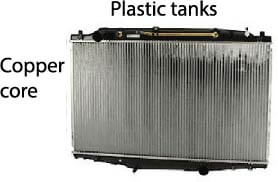
Plastic Aluminum radiator
To save even more money and some weight, car makers switched to an aluminum core with plastic tanks. The base
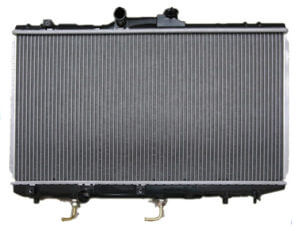
Typical down flow or vertical flow radiator
heat transfer rate of aluminum is lower than copper, but the tubes are wider and stronger so they actually cool faster than a copper core radiator.
Here’s an example of the cooling capacity of a copper core radiator versus an aluminum core unit
Where a copper/brass radiator uses 2 rows of 1/2 tubes for a total core thickness of 1.25″, a plastic aluminum radiator with the same cooling capability would have 1 row of tubes for a total core thickness of 1″. In heavy duty applications where a copper/brass radiator would have 3 rows of 1/2 in tubes for a total core thickness of 1-7/8″, a plastic aluminum radiator with the same cooling capability would have 1 row of 1-1/4″ tubes for a total core thickness of 1-1/4″.
Aluminum aluminum radiator
Radiators with aluminum tanks and cores offer 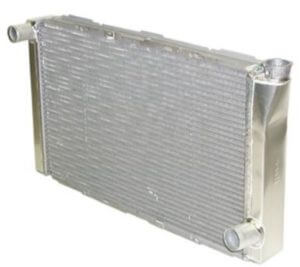 faster heat dissipation than a plastic aluminum version. They’re most often used in racing and off-road applications where proper cooling is critical.
faster heat dissipation than a plastic aluminum version. They’re most often used in racing and off-road applications where proper cooling is critical.
Which radiator construction is better?
You’ll see various opinions on this topic. The folks who prefer copper brass believe that it cools better because copper has a better heat transfer rate. But, copper tubes are smaller so the copper brass radiators require more rows to achieve the same cooling capacity as a comparable aluminum radiator. More rows means more resistance to airflow, which can negate the heat transfer properties of copper.
Copper isn’t as strong as aluminum and the tubes, headers, footers and tank are soldered together. Aluminum tubes are stronger than copper and the tubes , headers and footers are brazed using aluminum welding techniques. Finally, copper is more prone to corrosion than aluminum, making regular coolant changes a critical factor for radiator life. In addition to regular coolant changes, copper radiators are more susceptible to degradation due to improper coolant/water mix ratios.
For all those reasons, I prefer an aluminum core radiator.
Water pump moves coolant through the engine
The coolant circulating throughout the engine absorbs heat from around the cylinders and cylinder heat. The engine’s water pump then forces the hot coolant to the radiator where the heat is removed. If the flow rate is too fast, the coolant won’t pick up enough heat or lose enough heat while traveling through the radiator. If the coolant flow is too slow, the coolant will pick up too much heat while in the engine, possible causing it to boil.
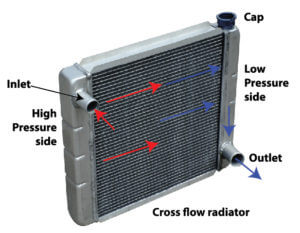
Hot high pressure coolant enters the inlet tank and flows across the tubes to the outlet tank. Airflow across the tubes cools the coolant and lowers both the temperature and pressure. Since the radiator cap is on the outlet tank, high RPMs won’t cause a pressure release
The flow rate is determined by engine RPM driving the water pump, the water pump design, the size and condition of the thermostat, the size of the radiator and the size and condition of the radiator fans. A failure in any of those components will affect engine cooling.
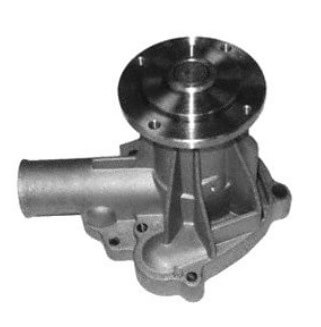
Typical belt driven water pump
How coolant flows through the engine
Coolant is sucked into the engine from the bottom of a down-flow radiator or the side opposite from the upper radiator hose on a cross-flow style radiator. The cooled coolant if forced around the cylinders and cylinder head(s) to pick up heat from those areas. Some hot coolant is diverted to the heater core to warm the passenger compartment. The hot coolant exits from the top of the engine and thermostat area and moves through the upper radiation hose to the top tank of a down-flow radiator or the intake side of a cross-flow radiator. Flow rate is determined by the thermostat.
Coolant heat is removed with fans and ram-air
As the hot coolant flows through the radiator fins, outside air is forced through the fins based on vehicle speed or pulled through the radiator fins with radiator fans. The rate of cooling is directly related to vehicle speed and radiator fan speed.
On a down-flow radiator, maximum cooling is achieved near the bottom of the radiator. On a cross-flow radiator, maximum cooling is achieved on the side opposite the upper radiator hose intake.
Electric radiator fans can be single, double or variable speed, depending on 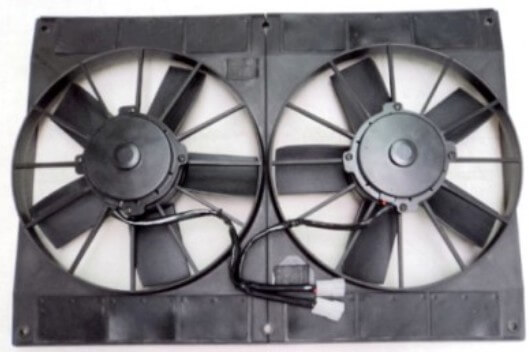 the year, make and model. Mechanical fans are driven by an accessory drive belt connected to the crankshaft. Most mechanical fans employ a temperature or electrically controlled viscous clutch. At high vehicle speeds where ram-air velocity is greater than mechanical fan RPM, the viscous clutch disengages the fan from the drive belt, allowing it to free-wheel. If the mechanical fan was not allowed to free-wheel at high vehicle speeds, the ram-air would slow the mechanical fan, causing an engine drag and lower MPG.
the year, make and model. Mechanical fans are driven by an accessory drive belt connected to the crankshaft. Most mechanical fans employ a temperature or electrically controlled viscous clutch. At high vehicle speeds where ram-air velocity is greater than mechanical fan RPM, the viscous clutch disengages the fan from the drive belt, allowing it to free-wheel. If the mechanical fan was not allowed to free-wheel at high vehicle speeds, the ram-air would slow the mechanical fan, causing an engine drag and lower MPG.
On late model vehicles with multiple electric radiator fans, one fan is often used to supplement the engine cooling fan when the AC system is operating.
Automatic transmission coolers
Vehicles equipped with an automatic transmission often incorporate an automatic transmission cooler inside the radiator. Since automatic transmission fluid temperatures are higher than engine coolant temperatures, the radiator does double duty by cooling both engine coolant and transmission fluid.
The transmission cooler is located at the bottom of a down-flow radiator and the suction side of a cross-flow radiator.
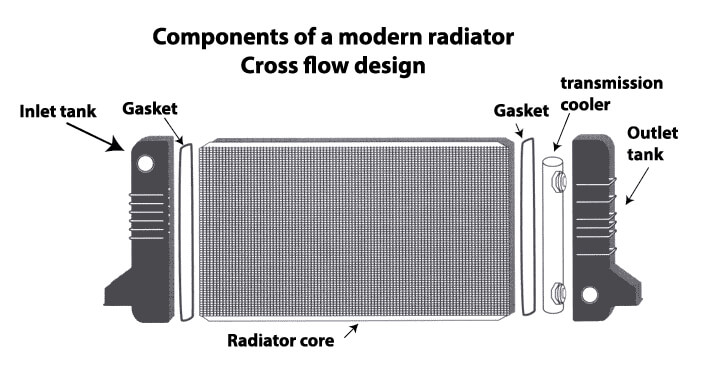
What goes wrong with a car radiator?
Corrosion and plugging is the most common failure and it’s always caused by owner neglect. Antifreeze/coolant contains anti-corrosive
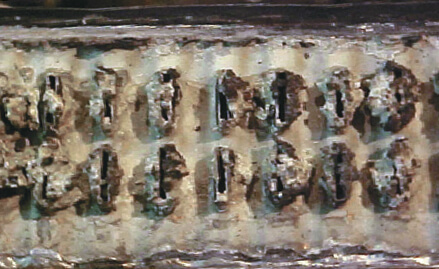
Corroded radiator tubes
additives that have a limited lifespan. When car owners exceed the useful life of the coolant, dissimilar metals in the cooling system begin a galvanic action that creates metal migration from one component to another. Some metal component thin and develop pinholes, while others accumulate excess deposits that
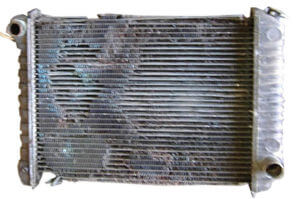
Corrosion has rotten out the tubes and fins
clog and impeded the flow of coolant. In addition, the loss of anti-corrosion inhibitors causes internal coolant system metals to corrode and settle in the small tubes of the heater core and radiator core.
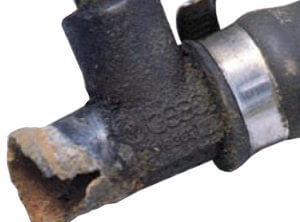
Worn out coolant can rot out metal heater tubes as well
Once clogged, it is almost impossible to clear out the small passages.
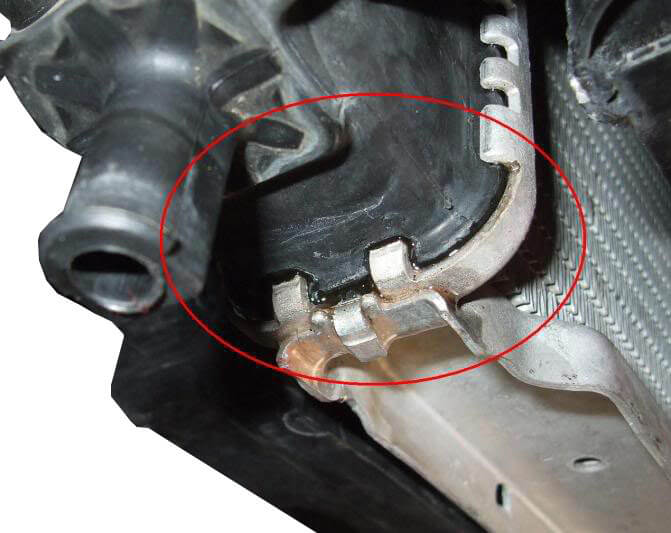
Seal leakage between the radiator core and the end tanks. On an aluminum radiator with plastic tanks, this leak is not repairable.
Even when cleaning is possible, the metal has been compromised and failure is likely to occur in the near future.
That same type of corrosion can cause the transmission cooler to develop leaks which can cause catastrophic transmission damage. Cooling system pressure can force engine coolant into the transmission, causing a severe lack of lubrication.
What’s the cost of radiator replacement?
Depending on the year, make and model, radiators typically cost around $400 for the part and require approximately one hour to install. Radiator replacement also requires a cooling system flush and refill with fresh coolant.
See other parts of the cooling system
Thermostat
©, 2017 Rick Muscoplat
Posted on by Rick Muscoplat
